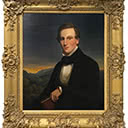Red-Billed Gull & Black-Billed Gull
48 x 36 cm
est. $16,000 - 22,000
PROVENANCE
Private Collection, Bay of Plenty Important, Early & Rare,
International Art Centre, 20/11/2013 Commissioned by the late Sir Walter Buller, author of Manual of Birds of New Zealand, and came by descent to his niece the late Gwendolin Buller, who bequeathed it to a close friend, Captain Charles Hamish Pelham Burn.
John Gerrard Keulemans was born in Rotterdam in 1842. The son of a fashionable military tailor, he chose, at an early age, to reject what would have been an assured place in the family trade to pursue the less secure life of an artist and naturalist. Keulemans initial interest lay in ornithology, and he began his career at the Leyden Museum as a freelance taxidermist. It was whilst at the Leyden that he came under the guidance of Professor Hermann Schlegal, who had in the past been a strong influence on the career of the eminent illustrator Joseph Wolf. It was Schlegel who instructed Keulemans in lithography, a skill which was to be a valuable asset in his later career, and it was he also who gave him his first professional commission illustrating. "Notes from the Leyden"
As Keulemans skill as an artist grew, so naturally did his discontentment with the inanimate subject matter available to him at the Leyden, he wanted to travel and indulge his passion for bird painting using live subjects in their natural habitat. It was for this reason that he joined a collecting expedition to West Africa, but this journey was to be ill fated as he contracted yellow fever and was forced to return to Europe and the less lively, if safer, atmosphere of the Leyden Museum, where he was to remain until 1869.
At this time London was the centre for ornithological and zoological journals and it was a natural progression for Keulemans to move to England to pursue his career. As he had collaborated with the English artist Richard Bowdler Sharpe in the past, whilst still working at the Leyden, his reputation was to some extent already established and in 1869 he moved to England where he was to spend the rest of his life.
Keulemans skill as a Lithographer and his detailed and meticulous work were to create for him a reputation which made his name a by-word in ornithological illustration in the late 19th century. He succeeded Joseph Wolf as illustrator with the prestigious journal, Ibis, continuing to be in demand as a freelance illustrator working alone and in collaboration with other artists on several volumes. His most notable works, however, are; Sir Walter Buller's, A History of the Birds of New Zealand, considered by many to contain some of his most beautiful and versatile illustrations, and the earlier volumes of Lord Lilford's Coloured Figures of the Birds of the British Islands, a gargantuan task which, due to ill health he was finally to hand over to Archibald Thorburn who completed its illustration. In the early work, however, Keulemans skill is evident and he displayed not only the accurate eye of a naturalist but also the truly aesthetic sense of an artist. Keulemans continued to contribute to various journals, claiming that by the time he was fifty he had drawn over 20,000 species of birds. Although he wrote only one volume himself, A Natural History of Cage Birds, his illustrations for the works of others created for him an acknowledged reputation as one of the finest Victorian ornithological illustrators.
This lot accompanied with a copy of Buller's Birds of New Zealand, Whitcombe & Tombs, 1967





